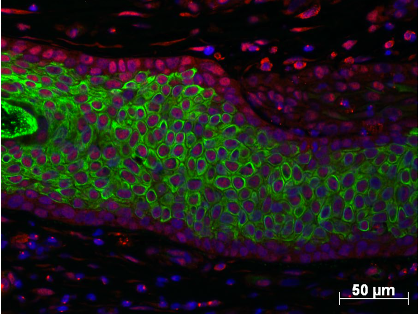What we investigate
We study how skin cells integrate signals from their environment, and how they respond to them by adapting gene expression and behavior. In particular, we study how the PPAR nuclear hormone receptors regulate gene expression and skin cell responses to environmental insults, like mechanical injuries, allergens or sunlight UV rays.
KEYWORDS
nuclear hormone receptors, skin cancer, skin repair, transcriptional responses, UV

Our research in more detail
Understanding how our cells maintain appropriate responses to insults, or in contrast how misregulated gene expression programs cause diseases, is of primary importance as it impacts our body's integrity. As our largest interface with the environment, the skin is an ideal model system to characterize how the regulation of gene expression controls cell responses to insults. Repeated exposure to insults can overwhelm the skin's ability to cope with damage, leading to pathological responses, like we see with UV-induced skin cancers. We particularly seek to characterize the genes and signaling pathways regulated by the PPARs in the skin exposed to mechanical trauma or sunlight UV rays. PPARs are transcription factors of the nuclear hormone receptor family that act as sensors and tune cellular responses by regulating the transcription of their target genes. Because their activity can be regulated by synthetic agonists and antagonists, PPARs are also attractive druggable targets. By studying how they control mouse and human cell responses to mechanical trauma or to UV, we provide insight into the functioning of key transcription factors and their potential for clinical applications.
Selected publications
SKINTEGRITY.CH Principal Investigators are in bold:
- Montagner A, Delgado MB, Tallichet-Blanc C, Chan JS, Sng MK, Mottaz H, Degueurce G, Lippi Y, Moret C, Baruchet N, Antsiferova M, Werner S, Hohl D, Saati TA, Farmer PJ, Tan NS, and Michalik L*, Wahli W* (2014) Src is activated by the nuclear receptor peroxisome proliferator-activated receptor beta/delta in ultraviolet radiation-induced skin cancer. EMBO Mol Med, 6, 80-98. *corresponding authors.
- Wawrzyniak M, Pich C, Gross B, Schutz F, Fleury S, Quemener S, Sgandurra M, Bouchaert E, C Moret, Mury L, Rommens C, Mottaz H, Dombrowicz D, and Michalik L (2015). Endothelial, but not smooth muscle, peroxisome proliferator-activated receptor beta/delta regulates vascular permeability and anaphylaxis. J Allergy Clin, 135(6): 1625-35 e5.
- Degueurce G, D'Errico I, Pich C, Ibberson M, Schutz F, Montagner A, Sgandurra M, Mury L, Jafari P, Boda A, Meunier J, Rezzonico R, Brembilla NC, Hohl D, Kolios A, Hofbauer G, Xenarios I, and Michalik L (2016). Identification of a novel PPARbeta/delta/miR-21-3p axis in UV-induced skin inflammation. EMBO Mol Med, 8, 919-936.
- Pich C, Meylan P, Mastelic-Gavillet B, Nguyen NT, Loyon R, Trang BK, Moser H, Moret C, Goepfert C, Hafner J, Levesque MP, Romero P, Jandus C, and Michalik L (2018). Induction of paracrine signaling in metastatic melanoma cells by PPARγ agonist rosiglitazone activates stromal cells and enhances tumor growth. Cancer Res, 78(22):6447-6461. https://doi.org/10.1158/0008-5472.can-18-0912
